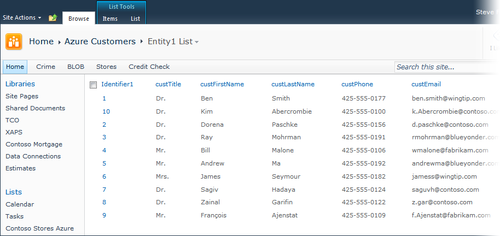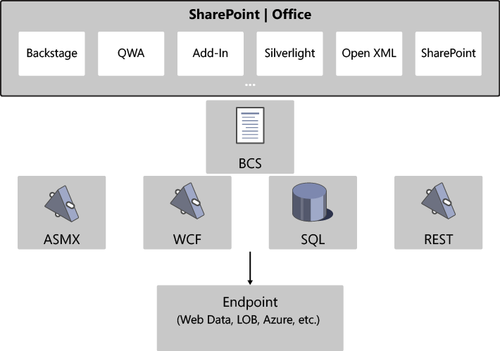One of the key requests from many companies is to
surface data within Microsoft SharePoint. Because SharePoint is used by
many different types of people in an organization, it is a great place
to surface line-of-business (LOB) data, the data that drives the daily
operations of a company.
1. What Is Business Connectivity Services?
Information workers
(IWs) often require access to all different types of structured and
unstructured LOB data that live in disparate systems such as SAP,
Microsoft Dynamics, or PeopleSoft. This presents a number of key
challenges for IT staff when serving IW needs. For example, to bring
data from these systems together in a unified and seamless way is
challenging; to maintain the cost of building, supporting, and training
can be prohibitive; and productivity is lost as end users context-switch
across different applications.
Bringing these systems
together is one of IT’s greatest challenges. It’s important that IWs
have access to this data, which can be both legacy and current, in a way
that keeps them productive. Productivity, however, is but one pivot in
the IT challenge; ensuring costs, both software and hardware, are kept
in check is another consideration that must be held in front of IT
planning.
To help alleviate the burden in this integration, SharePoint 2010 introduced BCS
as a way to integrate external data from systems such as SAP and
PeopleSoft with SharePoint. This integration manifests itself in ways
that were not possible in past releases of SharePoint; you can now
integrate with CRUD (create, read, update, and delete) operations to
manage data that lives in an external system directly from within a
SharePoint list. This new type of list is called an external list. It looks and feels like an ordinary list but operates much differently. For example, Figure 1
shows an external list—but the data is loaded only when SharePoint
loads the page that contains the list. So if you’re loading data from an
external system into SharePoint, when SharePoint loads the page, it
also calls the external system to make a request, and then loads the
resulting data from that system.

With BCS, you can integrate Microsoft ADO.NET connections (to systems such as SQL Server), web
services (to SOAP-based ASMX services), and Windows Communication
Foundation (WCF) services (to WCF services deployed to IIS, Windows Azure, or other locations). Further, BCS
provides a way for you to surface external data in both SharePoint and
Microsoft Office, map external data to Office, create read-only views of
the data in Microsoft Access and SharePoint Workspace, integrate external data directly into Microsoft Outlook, reuse data
connectors across the server and client, and bridge the world of
structured/unstructured data with the IW through BCS solutions.
As an example, consider a sales professional who must look up customer information from a customer relationship management (CRM) system such as Microsoft
Dynamics CRM, and then needs to get that information into SharePoint or
Office documents. To do that, the salesperson must copy field-level
data from the CRM system and paste it into SharePoint or Office. This
copy-and-paste process results in lost time, and the manual process of
moving data from one system to another can be error prone. If you
instead create a direct connection from the Microsoft Dynamics CRM
system by using BCS, when you load a document or open a list in
SharePoint, the data from the external system (in this case Microsoft
Dynamics CRM) is loaded into SharePoint or Office automatically. There
is no copy and paste to worry about.
And the IW can then engage with the document by using the customer
information without the worry of errors, lost time with copy and paste,
or other issues that might arise as a part of the manual process.
BCS is not just about integrating CRM data either: you can connect enterprise resource planning (ERP) data or supply chain management (SCM)
data, or even take unstructured data and create a reporting mechanism
through the process of modeling that unstructured data in Microsoft Visual Studio. Thus, BCS
provides a flexible way to primarily manage structured data from
external systems into SharePoint and Office, but it also enables you to
integrate unstructured data (such as data from blogs, wikis, Twitter, and so on) as well.
To give you a better sense for how you can integrate with data and services by using BCS, Figure 3-2
provides you with a high-level architectural view of the different
types of APIs and clients you can use (whether you’re using SharePoint
or Office) and the different services and data that you can model using
BCS. For example, in Figure 2 you will see that you can use REST feeds
to retrieve web data if you want to; this gives you the ability to
retrieve Twitter data and then model this for presentation within
SharePoint. Likewise, you can integrate with WCF services, which makes
it easy to connect with Windows Azure.

Although Microsoft SQL Azure is not an ERP system such as SAP, or a CRM system such as Microsoft
Dynamics CRM, it does manage data that is external to SharePoint and
Office and has a separate set of credentials (that is, a user name and
password that connect a user to a separate database server in the cloud)
that must be managed. SQL
Azure is our external data system. And much like you would interact
with an instance of SQL Server with an on-premises application, you’ll
build and deploy a cloud-based SharePoint solution that leverages BCS to integrate with SQL Azure data.
Note:
More Info For more in-depth information on Business Connectivity Services, visit http://msdn.microsoft.com/en-us/library/ee556826.aspx.
2. External Content Types
When you use BCS to create a connection between SharePoint and an external system, you create what is called an external content type (ECT).
An ECT is, in essence, an XML file that defines the relationship that
exists between the external system and SharePoint and Office by
representing properties such as the entities within the external system
(for example, Customer entity),
the operations that you want to manage against the external system (for
example, Read, Write, and so on), and the type of authentication with
the external system (for example, PassThrough). The ECT is the key
artifact that has advanced the BCS to being what it is today: a flexible
connection to structured and unstructured external systems.
You create an ECT by using
SharePoint Designer 2010 or Visual Studio 2010. When you use SharePoint
Designer 2010, you declaratively create an ECT and then directly save it
into the BDC Metadata Store in SharePoint. When you create an ECT using
Visual Studio 2010, you have a more flexible and structured approach as
a developer using a code approach, but rather than saving the ECT, you
deploy it as a Microsoft .NET Framework assembly into SharePoint; then
it is automatically added as a feature to SharePoint and the ECT is also
added to the BDC Metadata Store.
A number of properties exist
within the ECT that are key to establishing the connection to the
external system. Although there are many elements within the ECT, some
of the core elements are described as follows:
LobSystem An external data source, service, or software system.
LobSystemInstance Specific implementation of the LobSystem.
Entity Describes the structure of the business entity or object. It contains one or more Methods, fields (or TypeDescriptors), and a unique Identifier, and is made up of specific data types.
Methods Describe the back-end APIs with MethodInstances being the specific implementation of a Method. Methods can also contain filters (defined through the FilterDescriptor).
Parameters Defined through a TypeDescriptor and DefaultValue.
AssociationGroup Defines relationships across back-end systems.
The XML code in Example 1 shows a simple ECT.
You can see that there are a number of elements that make up this ECT,
which have their own properties. For example, in this ECT, the LOBSystem is called SQLAzureForSharePoint, and it’s of type DotNetAssembly. Further, it has been built using a generic entity (for example, custom class) called Entity1. The ECT has many more properties, and if you’d like to learn more about these properties, visit http://msdn.microsoft.com/en-us/library/ee556391.aspx.
Example 1. Sample ECT XML
<?xml version="1.0" encoding="utf-8" standalone="yes"?>
<Model xmlns:xsi="http://www.w3.org/2001/XMLSchema-instance"
xmlns:xsd="http://www.w3.org/2001/XMLSchema"
xmlns="http://schemas.microsoft.com/windows/2007/BusinessDataCatalog"
Name="SQLAzureForSharePoint">
<LobSystems>
<LobSystem Name="SQLAzureForSharePoint" Type="DotNetAssembly">
<LobSystemInstances>
<LobSystemInstance Name="SQLAzureForSharePoint">
</LobSystemInstance>
</LobSystemInstances>
<Entities>
<Entity Name="Entity1" Namespace="C3_SQL_Azure_For_BDC.SQLAzureForSharePoint"
EstimatedInstanceCount="1000" Version="1.0.0.0">
<Properties>
<Property Name="Class" Type="System.String">
C3_SQL_Azure_For_BDC.SQLAzureForSharePoint.Entity1Service,
SQLAzureForSharePoint</Property>
</Properties>
<Identifiers>
<Identifier Name="Identifier1" TypeName="System.String" />
</Identifiers>
<Methods>
<Method Name="ReadList">
<Parameters>
<Parameter Direction="Return" Name="returnParameter">
<TypeDescriptor TypeName="System.Collections.Generic.IEnumerable`1
[[C3_SQL_Azure_For_BDC.SQLAzureForSharePoint.Entity1,
SQLAzureForSharePoint]]"
IsCollection="true" Name="Entity1List">
<TypeDescriptors>
<TypeDescriptor
TypeName="C3_SQL_Azure_For_BDC.SQLAzureForSharePoint.
Entity1, SQLAzureForSharePoint" Name="Entity1">
<TypeDescriptors>
<TypeDescriptor TypeName="System.String"
IdentifierName="Identifier1" Name="Identifier1" />
<TypeDescriptor TypeName="System.String" Name="Message" />
</TypeDescriptors>
</TypeDescriptor>
</TypeDescriptors>
</TypeDescriptor>
</Parameter>
</Parameters>
<MethodInstances>
<MethodInstance Type="Finder" ReturnParameterName="returnParameter"
Default="true" Name="ReadList" DefaultDisplayName="Entity1 List"/>
</MethodInstances>
</Method>
<Method Name="ReadItem">
<Parameters>
<Parameter Direction="In" Name="id">
<TypeDescriptor TypeName="System.String" IdentifierName="Identifier1"
Name="Identifier1" />
</Parameter>
<Parameter Direction="Return" Name="returnParameter">
<TypeDescriptor
TypeName="C3_SQL_Azure_For_BDC.SQLAzureForSharePoint.Entity1,
SQLAzureForSharePoint" Name="Entity1">
<TypeDescriptors>
<TypeDescriptor TypeName="System.String"
IdentifierName="Identifier1" Name="Identifier1" />
<TypeDescriptor TypeName="System.String" Name="Message" />
</TypeDescriptors>
</TypeDescriptor>
</Parameter>
</Parameters>
<MethodInstances>
<MethodInstance Type="SpecificFinder"
ReturnParameterName="returnParameter"
Default="true" Name="ReadItem" DefaultDisplayName="Read Entity1"/>
</MethodInstances>
</Method>
</Methods>
</Entity>
</Entities>
</LobSystem>
</LobSystems>
</Model>
|
Warning:
Important
The lines in bold code in the preceding listing have been wrapped to
meet page size restrictions, but in your code, the quoted strings in
those tags must appear on a single line.
Now that you have been introduced to BCS and ECTs, the next sections walk you through four different practical examples that each use SQL Azure in some way. In the first, you’ll create a small database in SQL Azure. This exercise represents the process of creating
a database that can be treated as an external system. In the second
example, you’ll create an application ID that you can use to connect
securely to the SQL
Azure data source by using SharePoint 2010. In the third example,
you’ll create an ECT by using SharePoint Designer—connecting SharePoint
to your SQL Azure instance via the application ID and then setting the
permissions for the ECT by using SharePoint Central Administration. The
fourth and final walkthrough shows how you can use Visual Studio 2010 to
create a Visual Web Part that connects to SQL Azure to illustrate a second way to consume SQL Azure data in SharePoint.